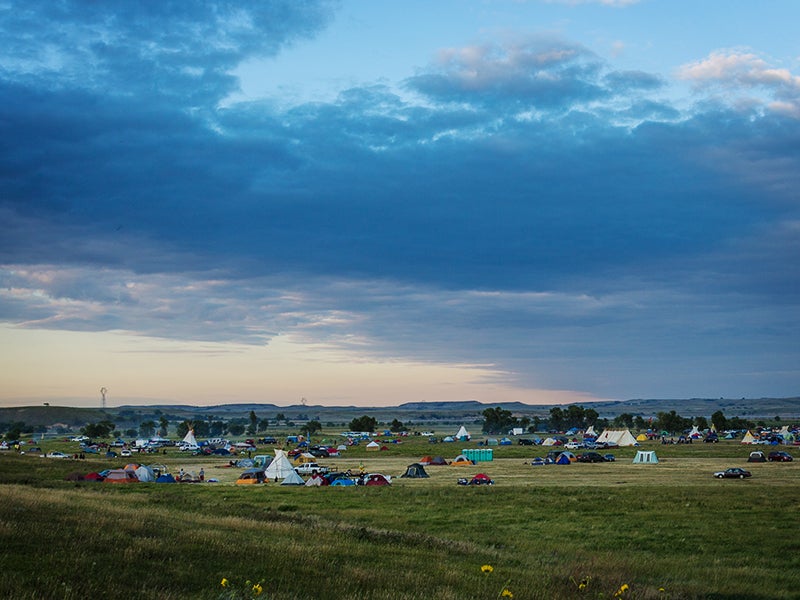Making History at Standing Rock: Tribes Are Leading Action to Preserve the Planet
The Standing Rock Sioux's stand against the Dakota Access Pipeline is a historic moment and one that matters to the climate movement.

This page was published 9 years ago. Find the latest on Earthjustice’s work.
In North Dakota, thousands of people are now encamped on the banks of the Cannonball River to oppose the Dakota Access pipeline with the Standing Rock Sioux. Routed through sacred sites, the $3.8 billion pipeline would transport Bakken oil under the Missouri River, where a break or leak would poison water for Standing Rock and potentially millions of people downstream. Members of at least 280 tribes and First Nations have come from around the U.S. and Canada to peacefully demonstrate, making this the largest gathering of tribes in generations. Delegations of indigenous peoples have come from as far away as New Zealand and the Ecuadoran Amazon, and more people arrive every day. “It’s powerful. It’s one of the most beautiful things that I’m fortunate to witness,” says David Archambault II, Chairman of the Standing Rock Sioux Tribe.
It’s a historic moment and one that matters to the climate movement. Beyond the massive Dakota Access pipeline, theStanding Rock Sioux have joined 49 other tribes and First Nations to create a united front against the full suite of new pipelines and other proposed infrastructure projects that would entrench dependence on oil. This leadership offers new hope for keeping oil unburned. But it is reductive to call Dakota Access the “next Keystone” as many commentators have done. Above all, this is a fight for justice, tribal sovereignty, and fundamental rights to protect land and water, to keep culture and “survive as distinct peoples,” as Leonard Peltier recently put it.
For my organization, Earthjustice, it is an extraordinary privilege to represent the Tribe in a lawsuit challenging the federal government’s deeply flawed process for permitting the pipeline. This 1,200 mile-long project is going forward without any comprehensive environmental review or meaningful consultation with the Tribe, as Dakota Access secured the necessary approvals from the U.S. Army Corps of Engineers using a self-service permitting scheme that is urgently in need of reform. While the Corps has insisted that the Tribe’s concerns about threats to water are unwarranted, the pipeline’s original route was shifted toward Standing Rock when it became clear that a leak or a spill would contaminate drinking water in the relatively prosperous, overwhelmingly white city of Bismarck. The Tribe did not have any meaningful say in that decision, and now the Tribe bears the risk of poisoned water. Meanwhile, the companies building the pipeline have rushed to bulldoze and destroy ancestral burial grounds that lie in the route’s new path.
For the Sioux, it’s a painfully familiar story. As Chairman Archambault wrote in a recent op-ed that ran in The New York Times:
To say that America’s prosperity comes at the tribes’ expense is a gentle critique given the history. Fossil fuel development and its flip side, climate change, represent a new assault on the tribes, and that injustice resonates around the world.
Indigenous people including the Standing Rock Sioux are unifying in an unprecedented way to combat that injustice, and they are enjoying tremendous success. This past spring, the Lummi Nation successfully enforced their treaty-protected fishing rights to block the largest coal port proposed in North America. Shortly before that, the Lax Kw’alaams First Nation in British Columbia turned down $1.5 billion from the oil giant Petronas, blocking a massive liquefied natural gas (LNG) plant in fragile salmon habitat. And these inspiring efforts are not exclusive to North America. Invoking their traditional land rights, the Wangan and Jagalingou peoples of Australia are standing between India’s Adani Group and what would be the world’s biggest coal mine (and another blow to the Great Barrier Reef). Meanwhile, in India, tribal protests are blocking an extraordinary number of new coal mines—at great personal risk to the protesters involved. These are just a few examples among many.
The common thread is that indigenous peoples around the world are leading essential action to preserve the planet. To quote Rebecca Adamson, the founder of First Peoples Worldwide, “It is not a coincidence that 80 per cent of the world’s remaining biodiversity is to be found on indigenous lands.”
With the gathering of so many indigenous leaders at Standing Rock, there is an unprecedented opportunity —and pressing need —to support their efforts in a sustained way that honors their priorities. Adamson makes the point that “less than one tenth of a percent of the hundreds of millions of aid and philanthropic dollars going to prevent, mitigate and adapt to climate change goes directly to indigenous peoples.” Even putting aside the unfairness of that allocation, it is out of step with the outsize contribution that indigenous leaders are making.
Which brings us full circle to progress in the Dakota Access fight. On September 9, a federal district court denied the Tribe’s request for a court order blocking further construction, but minutes after the opinion issued, the Justice Department and the Army Corps issued a joint statement announcing their desire to revisit approvals for the project in light of the Tribe’s concerns. The Corps has deferred the grant of final approvals needed to route the line under the Missouri River, and the agencies have promised to initiate “a formal, government-to-government consultation,” stating that “this case has highlighted the need for a serious discussion on whether there should be nationwide reform with respect to considering tribes’ views on these types of infrastructure projects.” While the future of the Dakota Access pipeline is still very much in question, this remarkable announcement represents a dramatic shift in position and tone by the U.S. federal government. That shift is a testament to the power of the movement that is growing in North Dakota. Now is the time to help it grow.
This blog was first published by Article 3 Advisors on October 5, 2016.